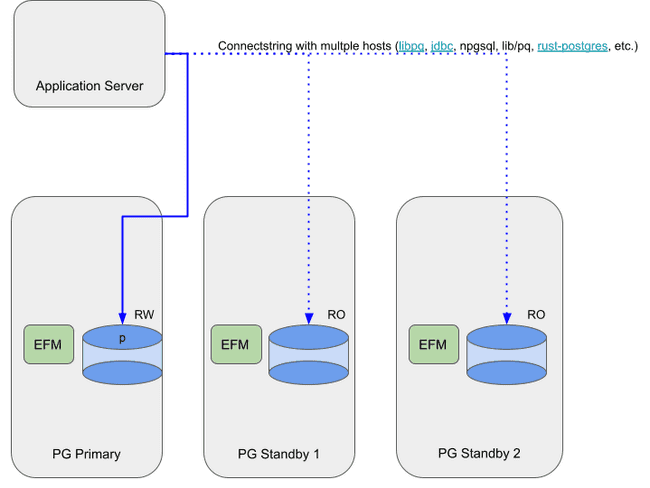Failover Manager with client connect failover v4
Most of the PostgreSQL connection libraries support client connection failover. These libraries support connection strings with more than one database server. On first connection attempt or when the connection is lost (which also occurs during a failover), the client driver connects to the supplied hosts one by one until it finds a read-write connection. The time for reconnecting to the new master depends on the connection timeouts as configured in the driver and TCP layer.

Figure 2: Failover Manager's traffic routing using client connect failover
Using Failover Manager with Client Connection failover
Installing
Install and configure Advanced Server and Failover Manager on three servers as follows:
| Systems | Components |
|---|---|
| PG Primary, PG Standby1, and PG Standby2 | Primary or standby nodes running Advanced Server 13 and Failover Manager 4.2 |
You don't need to configure the virtual IP configuration in efm.properties (virtual.ip,
virtual.ip.interface, virtual.ip.prefix, and virtual.ip.single).
Configuring Client Connection failover
| Driver | Client Connection failover support | Version supported | Configuration |
|---|---|---|---|
| JDBC | Yes | All supported versions | Supply multiple hosts in the connection string, and set the targetServerType attribute as primary. Example: jdbc:postgresql://host1:5444,host2:5444/accounting?targetServerType=primary. More information: https://jdbc.postgresql.org/documentation/head/connect.html#connection-failover |
| libpq | Yes | 10 and above | Supply multiple hosts in the connection string, and set the target_session_attrs attribute as read-write. Example: postgresql://host1:5444,host2:5444/edb?target_session_attrs=read-write. More information: https://www.postgresql.org/docs/current/libpq-connect.html#LIBPQ-CONNSTRING |
| .NET | Yes | 6 and above | Supply multiple hosts in the connection string, and set the Target Session Attributes attribute as primary. Example: Host=host1,host2;Username=test;Password=test;Target Session Attributes=primary. More information: https://www.npgsql.org/doc/failover-and-load-balancing.html |
| OCL | Yes | 10 and above | OCL is based on libpq, hence check libpq for details. |
| ODBC | No |